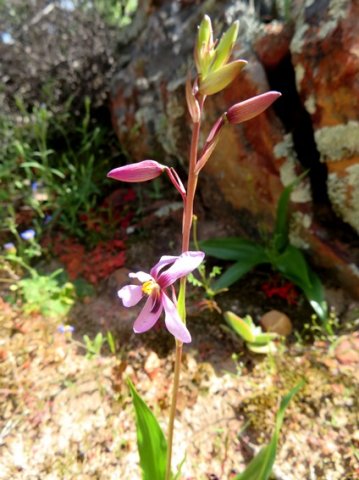Cyanella

Author: Ivan Lätti
Photographer: Thabo Maphisa
Cyanella is a South African and Namibia genus of about nine species of cormous perennials. Its small family, the Tecophilaeaceae, comprises six small genera occurring in the Americas and Africa.
The deep-seated, edible corms have long, thin necks and fibrous to hard outer tunics. The deep-seated feature may be an adaptation dealing with the porcupine and spurfowl proclivity for unearthing and eating the corms. The corms of particularly Cyanella hyacinthoides formed an important part of Nama tribe diets in Namaqualand in olden times, while raaptolle (turnip tops) as the plants are known in Afrikaans, were also roasted and eaten by early settlers.
The annual above-ground plant parts consist of basal leaves and a flower stem. Two to many leaves grow mainly in a rosette, the simple leaves lanceolate, ovate or linear in shape. They are sheathed at the base and there are more sheaths lacking blades.
The flowers grow in lax racemes or panicles on wiry peduncles. The individual pedicels are long, often curved. Flowers open in daytime, close at night and usually last for several days.
The perianth segments are free or only connected near the base, spreading to reflexed. Flower colours include white, pink, yellow, orange, brown, mauve or blue; sometimes bicoloured. There is a darker corolla centre, often a purple base, the veins often distinct.
The stamens occur in two forms, one or three of the six different in shape, size and position from the rest. Each anther has one pore at its tip through which pollen grains are released when certain solitary bee species, such as carpenter bees buzz their wings near the flower at a particular frequency. This buzz pollination functions in several flowering plant genera, particularly Cyanella and Solanum. The filaments are often short and fused, the oblong anthers yellow. The ovary is semi-inferior and conical on top.
The fruit capsule is globose to ovoid, borne erectly. The numerous, shiny seeds have wrinkled surfaces.
The plant in picture, as well as the leaf rosette in the background, are C. orchidiformis (Leistner, (Ed.), 2000; Vlok and Schutte-Vlok, 2015; Manning, 2007; iNaturalist).

